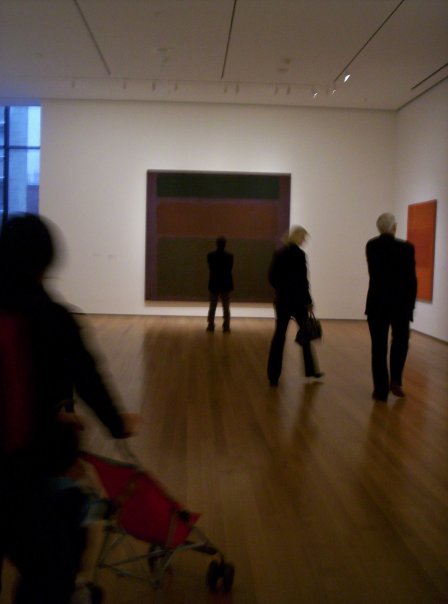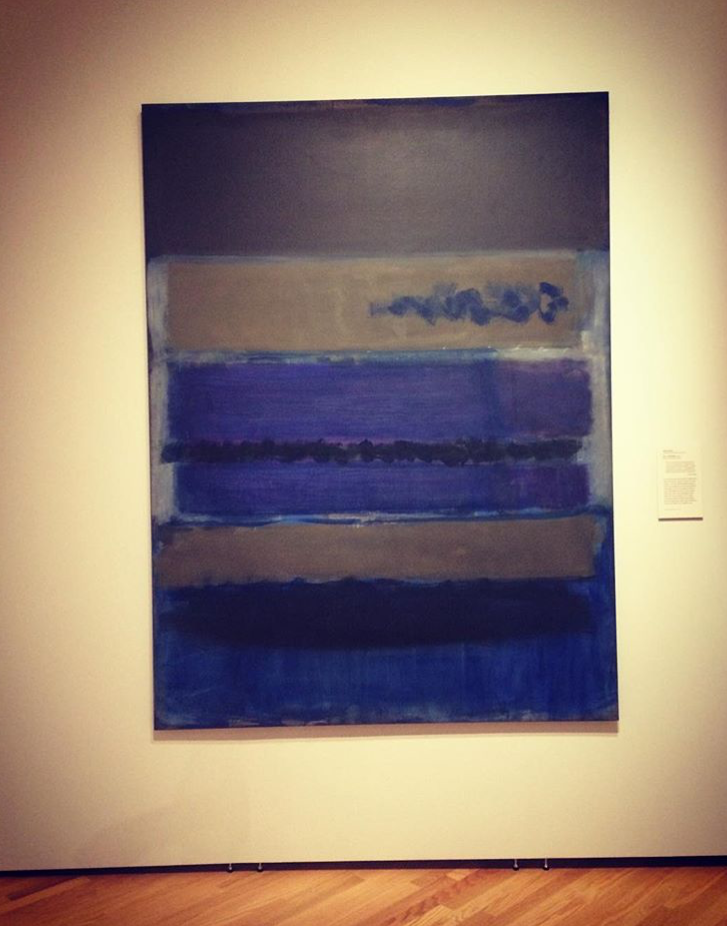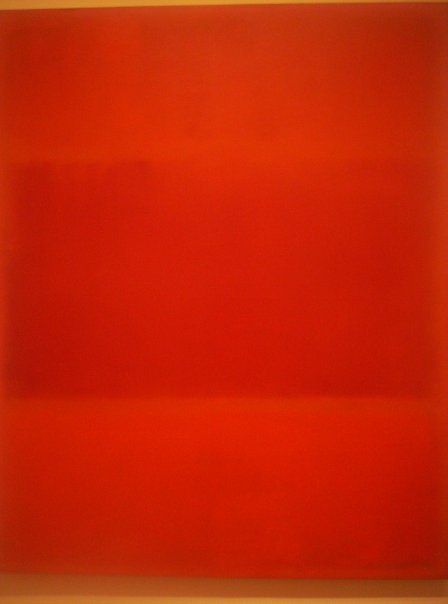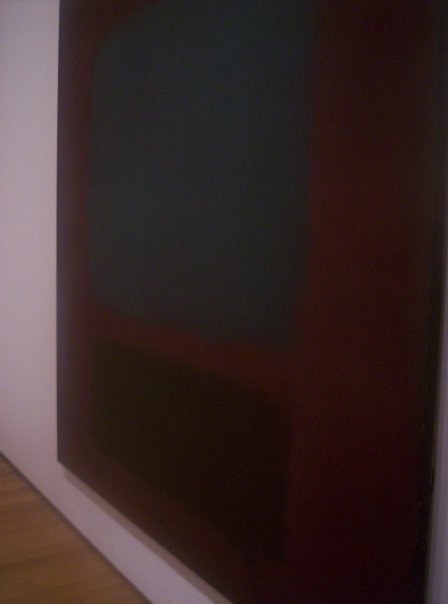A rendition of fancy sounding words about the painter Mark Rothko and how our love has gone…ahem…
“SIMPLE EXPRESSION OF COMPLEX THOUGHT.”
This statement lives under the title “ROTHKO” in a college notebook. Above that, lives the sub-heading Colorfield, and onwards up, Abstract Expressionism- also known as big squares of color that “I don’t get it” and my five year old could do that paintings.
The main heading reads IMPRESSIONISM TO THE YBA’S: RAPID FIRE ART HISTORY, in my handwriting. For what feels like the first time, I understand clearly why Mark Rothko’s work has been so important to me.
The same way any great work is appreciated, this importance is only understood now that something has died- my loving pursuits for Rothko experiences. The larger than life colorfields will always live as masterpieces. The artist will be forever honored as a concept and a romanticized notion of a man I never knew.
The sad confession is, I cannot speak of having a transcendental experience with a Rothko painting, in real life.
I have looked at slides and pictures, quietly gushing over the images like a person looking at the image of a lover in a distant land. Perhaps it was the aggressive dismissals of his work as stupid squares by some that made me want even more for them to mean something.
My first Rothko experience was at MoMA in New York City and my fondest memory of the experience is a photograph I took of someone else looking at his work.

How one might imagine the inquisitive peace of experiencing Rothko’s work…
From the moment I learned about Abstract Expressionism, I loved him- I loved the sensational experience of being transported, humbled, quiet, in awe- somehow submerged into a rich mysterious ether of emotional response. To feel. To really feel, something other than all the daily garbage feelings life offers.
…
My most memorable Rothko experience was THE LATE SERIES at Tate Modern in London. We were given classroom instructions to take notes of our first impressions, reactions, feelings, associations, and memories with the works. I became very upset and agitated by the inability to experience the work due to external intrusions…juggling my pens, notebook, bag, audio guide, people. As a popular exhibit, it was very crowded
My notes reflected the desire for a life enriching experience as preached by academic studies. This was juxtaposed with a seemingly selfish quest by others and myself, tangled and crowded to the point it was nearly impossible to see anything. I distinctly remember being overwhelmed, upset, and then fascinated by a blank space on one of the museum walls.
“why is there one blank wall? The incomplete journey. The missing piece. The infinite oblivion of space and time.” This was written across from my notes on Room 9: “ Darkness and the Horizon. What I like about Rothko is he isn’t an artsy, pretentious bastard keeping his own spiritual “enlightenment” to himself. He shares. He shows the viewer his and encourages them to have their own. HIS ART IS TIMELESS THERE WILL ALWAYS BE EMOTION.”
My best Rothko experience was emotional. At the later end of my 20’s, with a degree in Art History and a Master’s in Illustration, living at home with my parents, I was working a temporary full-time summer position cleaning stupid expensive, put nicely, not very impressive apartments near Cornell University in my hometown Ithaca, NY. It was hot and hard work and a horrible job. I was doing what I had to do.
In the lobby of one of the buildings, between the entry doors and the elevator lobby, hung three framed Rothko prints.
It was the most Rothko had ever meant to me. Cheap reproductions of transcendence. A comforting friend in a hard time.
…
My latest and maybe last Rothko experience was at the Chrysler Museum in Norfolk, VA visited with a close friend. Approaching the Modern Art section, there were no expectations- whatever was there was there and I’d be happy to see it.
To my wonderful surprise, there he was. My old friend…Rothko. In a completely people-less space. A combination of blues and greys on a light blue wall with high ceilings and that beautiful hardwood floor. An opportunity from heaven. I approached with caution given previous disappointments but an open mind to a new day.

color distortions courtesy of my instagram filter choices…
When the loud ramblings and screeching of a young child and a supposed adult figure guardian entered the far side of the gallery space. Annoyed but with patience, I waited to see if they would pass. It’s rude to be chaotic in an art museum, but I embrace personal autonomy, and am not an asshole, public spaces are not meant for me alone.
They did not leave, so I did, with the comforting knowledge that I would come back later. And I did. As I assumed the viewing position, a ruckus of machinery and beeping from a nearby closed exhibit-in-progress started. I promptly questioned if there was a means of killing myself right then and there. Then I could ask Rothko myself in Art Heaven to show me a painting. Very dramatic. Incredibly frustrating. Absolutely absurd.
So, evidently, there is no time or place adequate for seeing Rothko today. In my reflections of what his work and art in general is and means, I find a radical acceptance and a strange sense of awareness, a cathartic peace. I have not and no longer believe I can or will or want to experience a Rothko painting- a Rothkoian Transcendence. Our modern…. or would you call it contemporary…world is too abundant, fast-past, crowded, full of people, things, stimulus, external and internal luxuries, issues, and bothers. I know too much. I know nothing at all. It is, to me, profoundly tragic.
In that sense, I think Rothko would find that tragedy just as fitting. I wrote in front of the Seagram Murals that his art is timeless because there will always be emotion. There will always be emotion, even if that is the emotion in the absence of his work.
…
The most prominent personal influence is this idea of the simple expression of complex thought. In my work, I want to achieve this notion, but with representational and communicative images. How does a person condense the complexities of contradictions, paradoxes, and the entirety of our modern…contemporary times to be a simple expression?
am I even using modern and contemporary correctly?
Is that just the artists struggle? The complexities…not the proper use of modern and contemporary.
Unless by some miracle I find myself alone in the Rothko Chapel in Texas on a good day, I accept Rothko as a desire rather than an experience. Rothkoian Transcendence for me is dead.

I have sought transcendence through experiencing and making art. It’s cynical to say but with the bombardment of our world right now – there is no transcendence in Rothko. Or it’s rare. Or maybe it’s just me. Really I think though, the only true transcendence these days is in found in Nature.
How human beings collectively care about that is reflection enough of our condition. That isn’t something a Rothko painting can save.
